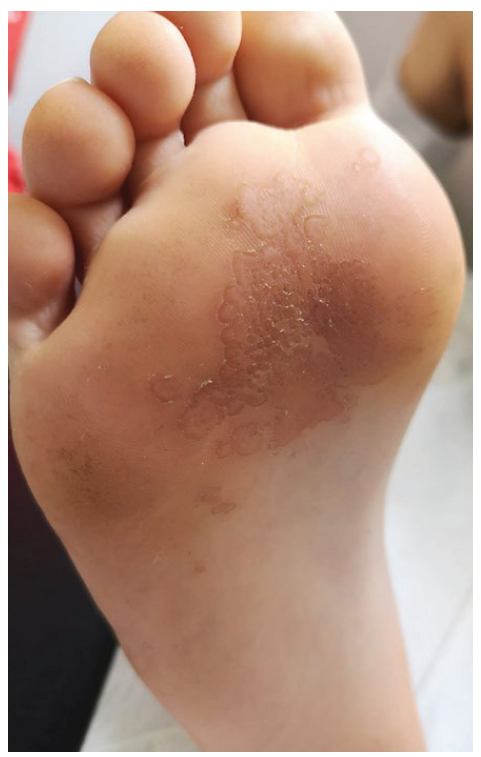A healthy 13-year-old non-atopic male presented with a month history of malodorous and slightly itchy skin lesions over both soles associated with hyperhidrosis. The patient used almost permanently occlusive footwear. On physical examination, we observed multiple yellowish-brown crateriform pits with punched out appearance and overlying thin scales associated with erosive areas coalescing on the metatarsal region of the plantar surface of both feet (Fig. 1). Non-pressure bearing areas were spared. Based on the clinical history and cutaneous findings, the patient was diagnosed with pitted keratolysis. Avoidance of occlusive footwear was recommended and topical mupirocin twice daily was prescribed for two weeks, with clinical resolution.

Figure 1 Multiple yellowish-brown crateriform pits and erosive areas on metatarsal region of the plantar surface of the right foot.
DISCUSSION
Pitted keratolysis (PK) is a relatively frequent superficial bacterial skin infection that typically affects pressure-bearing areas of the soles.1-5Etiological agents include Corynebacterium spp, Micrococcus sedentarius, Dermatophilus congolensis, Streptomyces, and Actinomyces keratolytica.3-5These bacteria produce proteases that digest keratin and destroy the stratum corneum, resulting in the characteristic crateriform pitting and erosions.3,5A malodorous foot odour occurs due to sulfur compounds produced by causal microorganisms, but it is not always present.5 Most cases are asymptomatic, although pruritus and a burning or pain sensation may occur on walking.2-5Predisposing factors include hyperhidrosis, prolonged use of occlusive footwear, humid climate, poor foot hygiene, obesity, diabetes mellitus and immunodeficiency.2-5Adolescents and young adults are more commonly affected.5 There is no racial predilection, but there is a male predominance, presumably due to males’ frequent use of occlusive footwear.2,5The diagnosis is clinical.3,5Main differential diagnosis include plantar warts and tinea pedis.1,3Topical antibiotic therapy, such as clindamycin, erythromycin, mupirocin or fusidic acid, twice daily, usually leads to resolution in 2 to 4 weeks.3,5Topical benzoyl peroxide is an alternative first-line treatment.5 Oral antibiotics are reserved for resistant cases.4,5Additional measures, such as treatment of concomitant hyperhidrosis and improving foot hygiene, promote clinical resolution and reduce the risk of reinfection.2,5















